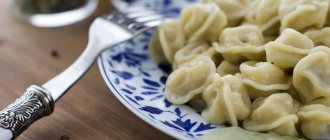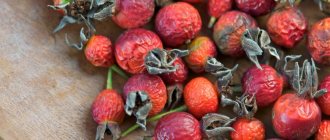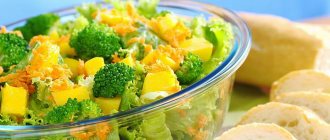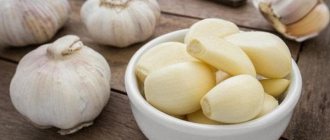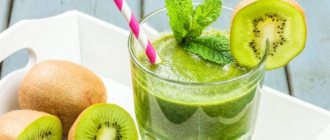Is it possible to have salads for gastritis?
The word “salad” in cooking refers to cold dishes made from various products with dressing. They are prepared from a variety of products, these can be vegetables, meat products, fish, and cheese. For gastritis, it is allowed to include only dietary foods and dishes in the diet.
They should not contain ingredients that irritate the gastric mucosa. Therefore, you will have to give up heavy multi-layer snacks, in which each layer is sandwiched with a large amount of mayonnaise. Such food is difficult to digest and can cause heartburn even in healthy people.
When preparing salads for a patient with gastritis, it is recommended to choose only dietary products of impeccable quality
In addition, if you have gastritis with high acidity, you should avoid snack foods that are seasoned with lemon juice and vinegar. Do not use too hot seasonings. For this reason, all Korean snacks with sour and spicy dressings fall into the prohibited section.
Is it possible to eat salads with gastritis of the stomach and what kind? These are dishes made from boiled and fresh vegetables, lean meat products and fish. Refined vegetable oil, not sour and not too fatty sour cream are used as a dressing. Unrefined vegetable oil is considered the healthiest, but it is not recommended for people with gastritis to season dishes, as the oil can irritate the stomach.
To prepare salads for a patient with gastritis, it is recommended to choose only dietary products of impeccable quality. Everything should be fresh and good quality. You should not prepare snacks for future use for two or three days; they should be eaten immediately after preparation.
What products can be used to prepare salads for patients with gastritis:
- Vegetables: This is usually a must-have ingredient. It is allowed to use boiled vegetables - potatoes, carrots, green beans, broccoli and cauliflower. Fresh vegetables are used with caution as they may cause bloating due to gas formation. To prepare snacks, you can use peeled cucumbers, raw carrots, fresh tomatoes without skin and seeds. However, if you experience abdominal discomfort after eating one of the listed varieties of vegetables, you will have to stop using it;
- fruits: if you have gastritis, not all fruits can be eaten. It is allowed to use pears, apples (sweet varieties), apricots, persimmons, and watermelon. It is better to remove the skin from the fruit. If you are intolerant to fresh fruits, you can prepare a salad of baked pears and apples;
- meat products: you can use lean meat - veal, turkey, rabbit. The meat is pre-boiled and cooled. Good quality doctor's boiled sausage can be used to add to salads;
- seafood and fish: it is recommended to choose low-fat fish; this ingredient is used boiled. You can use boiled shrimp, squid, mussels;
- greens : it is allowed to use lettuce leaves, dill, parsley, spinach;
- dressing: it is best to use refined oil, low-fat sour cream, natural yogurt. Spices are added in minimal quantities.
Fruity option
Fruits for gastritis can be eaten raw and heat-treated, and can also be used to make salads.
Non-acidic varieties of apples and pears, seedless grapes, and sweet watermelon will come to your aid when you want “something like that.”
How to cook
Peel the fruit, remove the seeds, chop finely, season with low-fat homemade yogurt - you get a dietary dish that meets the most demanding tastes.
Fruit salads are a great dessert and can also be used as a snack.
What salads can you eat if you have gastritis?
https://youtu.be/FYjPVlIQg_M
The main requirement for dishes with gastritis, including salads, is that they do not irritate the gastric mucosa. This means that salads for gastritis should not contain spicy vegetables, such as radish, horseradish or pepper. In addition, the salad should not overload the stomach and be too filling, and should not lead to excessive gas formation.
Therefore, if you have gastritis, you should not put a lot of potatoes, eggs, meat, green peas or mayonnaise in salads. Smoked and pickled foods, as well as all kinds of delicacies, such as Japanese, Korean or Chinese salads, are harmful for gastritis. And finally, all salads for gastritis must be absolutely fresh, therefore, they must be eaten immediately after preparation.
All products that you put in the salad should be the freshest and well chopped. The main task for gastritis is to facilitate the digestion process as much as possible. Vegetables and fruits need to be peeled because they consist of coarse fibers that will irritate the stomach lining. For the same reason, it is recommended not to salt salads, or at least not to over-salt them.
For gastritis with high acidity, it is recommended to take vegetables for salads boiled or steamed. If the acidity is low, then on the contrary, fresh vegetables will be the most useful. If we are talking about fruit salads, then you need to completely exclude hard or sour fruits and berries. For gastritis, it is recommended to eat only tender and sweet fruits that will not irritate the gastric mucosa.
Recommended herbs are dill or parsley. Salads should be dressed with low-fat yogurt or refined vegetable oil. And, of course, vinegar or lemon juice should be completely excluded from the dressing. If you add meat to the salad, then you need to take lean beef, veal, poultry or rabbit. Fish can also be exclusively low-fat varieties - cod, pollock, hake or trout. Any kind of seafood is suitable, the most important thing is that they are not marinated, but boiled.
https://youtu.be/c2qXfoUOfZA
Main conditions
There are several culinary rules to remember when preparing salads. Here they are :
- Vegetable salads cannot be prepared for future use. Chopped vegetables retain their nutritional value for an hour.
- Dress salads immediately before serving. If you have gastritis, you should not use mayonnaise, vinegar, fatty and sour sour cream as a dressing.
- Vegetable salads are best consumed at lunch; they are not digested in the morning.
- For hyperacid and erosive gastritis, it is better not to eat raw vegetables, preferring boiled ones.
Salad recipes for gastritis
There are a number of foods that should never be consumed if gastritis is diagnosed. Vinegar should not be used when preparing salads. You should exclude fast food and any processed foods from your diet. Sausages, sausages, crackers and chips contain many harmful additives that negatively affect the gastric mucosa. You cannot prepare a salad from sauerkraut if you have gastritis. All acidic foods are contraindicated.
You can't eat too hot spices. Bitter vegetables such as radishes, onions, radishes and garlic contribute to irritation of the mucous membranes. That is why they should not be added to salads. Peas are also prohibited. The thing is that this product can cause severe flatulence.
Experts advise chopping all foods as finely as possible during cooking. This way the food will be digested faster and easier. Don't use too much salt. This will have a negative effect on your stomach. Food must be seasoned immediately before serving. If this is done in advance, then the salad will most likely have time to oxidize under the influence of air and will no longer be so healthy.
Experts advise chopping all foods as finely as possible during cooking so that the food will be digested faster and easier.
Salad with white cabbage for gastritis
Ingredients: 200 g white cabbage, 20 g dill, 40 g sour cream, 6 g sugar, 2 g salt.
After removing the top limp and contaminated leaves, wash the white cabbage, cut it into two parts, chop it, and put it in a salad bowl. Sprinkle with salt and stir, rubbing lightly. Leave for 30 minutes to soften, then season with sour cream mixed with sugar. Before serving, sprinkle with chopped dill.
Beetroot salad with prunes for gastritis
Ingredients: 200 g boiled beets, 60 g prunes, 4 g sugar, 20 g vegetable oil, 1 g salt.
Wash the prunes, pour boiling water over them and leave to soak for 1 hour. After this, place in a colander, let drain, remove the seeds, and chop finely. Peel the boiled beets, grate them on a fine grater, mix with prunes, add sugar and salt, and put in a salad bowl. Season with vegetable oil.
Kohlrabi and apple salad for gastritis
Wash the kohlrabi, remove the peel and grate the woody areas on a coarse grater
Ingredients: 200 g kohlrabi, 100 g apples (sweet varieties), 20 g vegetable oil, 1 g salt.
Wash the kohlrabi, remove the skin and woody areas, and grate on a coarse grater. Wash the apple, remove the core and seeds, chop and mix with kohlrabi. Salt the salad and season with vegetable oil.
Vegetable vinaigrette for gastritis
Ingredients: 100 g beets, 100 g carrots, 120 g potatoes, 40 g green onions, 80 g pickles, 50 g sauerkraut, 20 g vegetable oil, 0.5 g lemon juice, 2 g sugar, 4 g salt.
Boil potatoes, beets, carrots in their skins, then cool and peel, cut into slices, cucumbers into slices. Combine the prepared vegetables with sauerkraut, sprinkle with lemon juice, mix and season with vegetable oil, sugar and salt. Place in a salad bowl in a heap, sprinkle with chopped green onions.
Olivier recipe for gastritis
A diet for gastritis does not exclude the use of Olivier. However, when preparing this dish, you must adhere to several important rules. This salad includes 2 medium potatoes, 2 eggs, 200 g chicken meat, 1 carrot, 1 medium-sized apple, 1 fresh cucumber, canned peas and 5 tablespoons of low-fat sour cream.
Diet for gastritis does not exclude the use of Olivier
Chicken fillet, potatoes, carrots and eggs need to be thoroughly boiled and cut into cubes. After this, you need to add chopped and peeled cucumber and apple to the crushed products. Next, add peas, sour cream and a little salt to the salad. Everything gets mixed up. The healthy salad is ready.
Eggplant caviar
Ingredients: 200 g eggplants, 40 g onions, 90 g fresh tomatoes, 20 g vegetable oil, 10 g green onions, 4 g sugar, 4 g salt. Wash the eggplants, remove the stem, place in an oven preheated to 120°C, and bake until tender. When they have cooled, remove the skin and chop the pulp. Chop the onion and sauté in vegetable oil.
Add the tomatoes cut into slices and sauté for 5-10 minutes. Add eggplants to the mixture and simmer for 25–30 minutes until thickened. 10 minutes before the end of stewing, sprinkle with salt and sugar. Before serving, cool the caviar, transfer it to a salad bowl and sprinkle with chopped green onions.
Salads for every day
The recipes for most salads recommended for gastritis are easy to prepare. This group includes vitamin mixtures that are served at every meal.
- Fresh white cabbage salad with carrots. Add carrots and a pinch of salt to shredded cabbage. The mixture is thoroughly mixed, lightly squeezing until the vegetables release juice. Season with vegetable oil.
- Carrot-apple salad with sour cream. Grind the carrots, add peeled grated apple, add sour cream.
- Boiled beet salads. The root vegetable is boiled, cut into thin strips or grated. Season with butter or sour cream. For variety, add grated vegetables or fruits: carrots, apples.
- Apple-carrot. Fresh fruits are passed through a grater. Served with greens. You can add grated fresh cucumbers and finely chopped tomatoes to the dish. Season the dish with olive oil or sour cream.
- Potato. Boil potatoes and carrots, peel them and cut them into cubes. Prepare the dressing: dilute the sour cream with a spoon of warm water, add a few drops of lemon juice. The resulting sauce is added to the vegetable mixture.
https://youtu.be/-fxk7FhCeDY
What salads are suitable for different types of gastritis?
Gastritis does not require separate meals, so salads containing foods that do not harm the stomach individually can be eaten. But their preparation must comply with certain rules. Since gastritis is characterized by inflammatory-dystrophic changes in the mucosa with different localization and secretion of gastric juice, the nutritional requirements are different.
Salads for gastritis with high acidity
Salads for gastritis with high acidity - they should mainly combine products that do not cause irritation of the stomach walls: boiled vegetables, lean meats (turkey, chicken, veal, rabbit), fish (hake, natothenia, pollock, cod), various greens, diet sauces. It is best not to include sour varieties of fruits, with rough skin, pickled preparations for the winter, white cabbage, and bell peppers in the dish.
Salads for gastritis with low acidity
Gastritis does not provide for separate meals, so salads containing foods that do not harm the stomach can be eaten separately. Salads
for gastritis with low acidity - the use of fresh vegetables and fruits (ripe tomatoes, cabbage, orange, tangerine), soaked herring, boiled meat and fish is allowed , soft-boiled eggs, green peas, meat, mushroom, vegetable and fish broths can be used for sauces.
Salad for reflux esophagitis and gastritis
Salad for reflux esophagitis and gastritis - with this disease, stomach contents reflux into the esophagus, which causes painful heartburn and other unpleasant sensations. Therefore, the main task of a person is to organize nutrition that does not cause increased production of hydrochloric acid and does not irritate the walls of the organ. It is very important not to eat cold salads from the refrigerator; the so-called warm ones are most suitable here. An important feature is grated or finely chopped ingredients and small single portions.
Salads for exacerbation of gastritis
Salads during exacerbation of gastritis - this condition requires a strict diet, including pureed mucous soups with water, viscous porridges, and mashed boiled vegetables. Even some cereals, for example, buckwheat, are pureed, salt is limited, and coarse fiber is excluded. It is difficult to introduce salads into the menu during this period. After the acute symptoms are relieved, and this will take at least a week, you can slowly combine foods that are neutral in taste, for example, rice and finely chopped baked chicken fillet or boiled fish, sprinkled with melted butter.
Basic nutrition for the treatment of gastritis
The essence of therapeutic nutrition is to minimize the risks of any irritation of the inflamed mucous membrane - mechanical (rough and dry food, large pieces, hard fibers), thermal (very hot and very cold food), chemical (salty, spicy, sour, pickled, smoked, fried, fatty).
The diet of a patient with gastritis consists mainly of liquid and pureed foods, pureed and creamy dishes, viscous porridges, delicate soufflés, and soft foods. Steamed meat and steamed fish are allowed, which must be chewed thoroughly.
During the period of remission, you can eat salads. No matter how thoroughly a person chews, pieces of food from the salad will still be swallowed unchewed or not chewed enough. Therefore, salads can be eaten when the disease does not make itself felt and the patient feels comfortable, that is, the mucous membrane is in normal condition and is able to accept solid food.
Salads should be served warm, if the recipe allows it, or at room temperature.
What salads are possible for gastritis?
You can eat different salads for gastritis: vegetable, with meat or fish, fruit. If you use approved products, they will not cause harm. There are many recipes, but statistically most people use traditional dishes. Most often, patients with gastritis eat a salad of tomatoes, carrots, beets, vinaigrette or Olivier salad.
But it is allowed to diversify the diet with fruit, seafood or meat. The main thing is that they do not contain prohibited products. Most often, during remission of the disease, a vinaigrette is recommended. But you need to cook it according to a modified recipe. What remains from the traditional vinaigrette are boiled potatoes, carrots and beets. Instead of canned peas, it is better to add boiled fresh frozen ones if they do not cause flatulence.
With hyperacid gastritis, nothing else can be added, and if the acidity is low, a little pickled cucumbers or sauerkraut are allowed. You need to season the vinaigrette with vegetable oil. You can also make lighter salads. For example, a salad of tomatoes and cucumbers is popular.
They need to be peeled, chopped, seasoned with vegetable oil or low-fat sour cream. You can also add dill or parsley. Beetroot salad is also useful for gastritis. Be sure to boil it. If mixed with prunes, this dish is a great remedy for constipation. If there is no flatulence, you can make a salad with white cabbage. It is especially useful for gastritis with low acidity. You can simply chop the cabbage and carrots, mash them with your hands and season with oil. Or additionally add a boiled egg and season with sour cream.
Exit the American way
We suggest you borrow a recipe from American restaurants and prepare a Cobb salad. This simple but very beautiful dish will decorate your table not only on weekdays, but also on holidays. The cooking principle, which was invented by an American named Cobb, is simple - all the salad ingredients are beautifully cut and placed on a dish in rows, for example:
- 1st row - fresh cucumber;
- 2nd row – boiled egg;
- 3rd row – boiled meat or poultry;
- 4th row – fresh tomatoes;
- Row 5 – leaf lettuce.
Before serving, real Cobb salad is topped with a sauce made from vegetable oil, wine vinegar and honey, but this dressing is not suitable for gastritis.
Therefore, get creative and come up with your own dressing options - let it be any vegetable oil with a drop of lemon juice or soy sauce. If you do without dressing at all and just add a little sea salt to the vegetables, that’s also fine.
There are many options for preparing Cobb salad. You can use any products allowed for gastritis, and the holiday dish will be completely dietary.
Recommendations for eating salads for gastritis
Gastroenterologists encourage patients to diversify their boring diet. However, remember that all products that you want to add to a salad or other dish must be of high quality and fresh.
If you suffer from low acidity, then the salad can be varied with cucumbers, tomatoes, all types of cabbage and bell peppers.
If you suffer from low acidity, then the salad can be varied with cucumbers, tomatoes, all types of cabbage and bell peppers. For gastritis with high acidity, fresh herbal ingredients are prohibited, as they cause irritation and discomfort to the diseased organ.
Doctors' advice when preparing salads for gastritis
Choose low-fat and unsalted cheeses. A serving of the product is 30 g. Do not consume it more than once a week so as not to aggravate gastritis. Contrary to popular opinion among doctors, you can eat garlic for gastrointestinal diseases, but not more than 2 times a week. To eliminate the bitterness of onions, you need to steam them in boiling water for 10 minutes, and then rinse them under cold water. You can also sprinkle it with sugar. It is permissible to use soaked ginger as a seasoning.
Sources:
- https://www.owoman.ru/cook/salaty_pri_gastrite.html
- https://gastro.neboleite.com/informacija/kakie-mozhno-est-salaty-pri-gastrite-i-recepty-ih-prigotovlenija/
- https://gastrit03.ru/info/dieta/salaty-pri-gastrite.html
- https://biofile.ru/bio/20524.html
- https://ilive.com.ua/food/dieticheskie-salaty-pri-gastrite-recepty_129962i15888.html
- https://fb.ru/article/409404/salatyi-pri-gastrite-s-povyishennoy-i-ponijennoy-kislotnostyu-dieticheskie-retseptyi
- https://gastrox.ru/diet/salaty-pri-gastrite.html
Post Views: 2,686
Green benefits
The first vegetables that are included in the diet in spring are leafy salads.
There are more than 1000 varieties of vegetables in the world; we will focus on the most popular varieties allowed for gastritis. Leafy greens, like all raw vegetables, stimulate the production of hydrochloric acid. Therefore, with increased secretion, with erosive and atrophic gastritis, it is consumed in limited quantities, no more than once a week, giving preference to boiled vegetables.
- Lettuce is a champion in potassium content. Very useful for patients who suffer not only from gastritis, but also from diseases of the cardiovascular system. It is easily absorbed and does not burden the stomach.
- Iceberg , which looks like cabbage, contains a lot of fiber and is digested quickly and easily in the stomach. A very fashionable variety, it is the main ingredient in the popular Caesar salad. If the acidity of gastritis is not changed, Iceberg can be consumed as a snack before lunch, seasoned with low-fat sour cream or natural yogurt. Not recommended for high acidity.
- Arugula is an interesting variety of lettuce, a champion in iodine content. It is a “relative” of dandelions. It is very useful for diseases of the thyroid gland, but is not recommended for gastritis due to the bitter taste of the leaves. Strongly stimulates digestion, which can cause aggravation of gastritis.
- Chicory. Also a kind of salad, but quite aggressive for the stomach. Therefore, chicory for gastritis can only be used as a coffee substitute, but not as an independent dish.
- Spinach. This is a real godsend for patients with gastritis of any form. The peculiarity of this variety of leaf lettuce is that the beneficial substances do not disappear during heat treatment. Therefore, spinach can be used not only with normal acidity in its raw form, but also with other forms of gastritis - erosive, hyperacid, atrophic - after heat treatment. Soups, purees, sauces are made from spinach, and pies are stuffed with it. Digests quickly and does not burden the stomach.
Rules for nutrition and preparation of salads
Following simple rules of nutrition and preparing salads for stomach inflammation will help not only avoid exacerbations and complications, but will also contribute to a speedy recovery.
How to eat and prepare meals:
- eat small portions, preferably at the same time;
- food should not be hot or cold;
- eat only freshly prepared dishes, chewing food thoroughly;
- If the acidity is high, steam, bake, or boil vegetables. For gastritis with low acidity, you can eat fresh vegetables and fruits;
- vegetables and fruits must be without peel;
- For dressing, use low-fat sour cream, honey, cream, refined oil; unrefined oil has an adverse effect on the stomach. All other sauces, including mayonnaise, will have to be abandoned during an exacerbation;
- in case of exacerbation, avoid freshly squeezed juices and carbonated drinks;
- keep a food diary that will help you control the foods you eat and their quantity;
- The optimal amount of vegetable salad consumption per day for an adult is 3-4 servings. This is approximately a small plate of fresh vegetables, half a plate of boiled vegetables, half a glass of vegetable juice.
What products are prohibited from being added?
It is better not to include these ingredients in your diet, otherwise they will cause a new attack of exacerbation of the disease:
- Smoked meat and fish are prohibited. This also includes fatty fish. It is also better not to add various canned fish and cod liver to salads.
- Sausages, frankfurters, store-bought crackers, and chips are strictly prohibited. These processed foods contain many additives that irritate an inflamed stomach.
- Vinegar. It is often added to salads. However, it provokes exacerbation of gastritis and even the appearance of ulcers.
- Mayonnaise is a dressing that is difficult to digest even for a healthy stomach. Mayonnaise contains various additives, vinegar, and raw eggs, which are poorly accepted by the gastrointestinal tract.
- Sour, pickled and salty ingredients. For example, sauerkraut, pickled cucumbers or tomatoes.
- Spicy seasonings. Spices that are not too hot are allowed, but they must be used with caution.
- Onions, garlic, radishes, and radishes also irritate a sore stomach.
- Spicy Korean, Japanese and Chinese salads are prohibited.
What dishes to prepare for ulcer sufferers
Recently, diseases of the gastrointestinal tract (gastrointestinal tract) have been diagnosed more and more often, and in people of different ages and social status. To successfully treat and maintain the disease in remission, medication alone is not enough; it is important to follow a proper diet. Meals for ulcers should be gentle, properly prepared and take into account the characteristics of this disease. Improper nutrition reduces the effect of treatment to zero, and the disease continues to progress. We will talk about what dietary dishes should be and how to prepare them deliciously in this article.
Use in cooking
Before you prepare a salad appetizer, you need to prepare it. To do this, first of all, cut the roots from the bunch, and then carefully separate them into leaves. During the disassembly process, it is necessary to remove any weeds that have accidentally entered, and remove leaves that are damaged or have signs of drying. Next, the selected sheets are washed under running water or in a large container. You should carefully examine the axils of the leaves, because soil may remain there or insects may hide there. Wash the salad in very cold water, it gives the salad additional elasticity.
The washed leaves are dried with a towel or paper napkins. For various salads, you can use whole leaves or tear them into small pieces by hand. Less often, the recipe involves cutting the salad with a knife; in this case, you need to make sure that the tool is sharp so that it does not crush the leaves.
Prepare the salad immediately before serving, otherwise there is a chance that it will quickly wither. For one serving, it is enough to use 50 g of greens. In order for the salad on the table to delight consumers with a pleasant taste and enrich it with a variety of vitamins, several important rules should be taken into account.
- When cooking, it is better to leave small leaves whole, and tear large leaves with your hands instead of cutting them with a knife.
- Do not prepare the salad long before serving. It is prepared just before the meal, and seasoned immediately before consumption.
- For all its attractiveness, salad is used not only to decorate dishes; it is served as a side dish, an addition to protein products, or as an independent snack.
- It goes perfectly with garlic or lemon juice, in which case it doesn’t even need to be salted.
- More is not always better, which is why it is not recommended to use several varieties of lettuce in one dish. The only exception is the appetizer, which is prepared specially from several types of salads.
By following these rules, every gourmet will have the opportunity not only to enjoy the taste of the popular vegetable, but also to receive a powerful vitamin boost.
The healing power of salads
Multicomponent mixtures are rich in microelements and vitamins. Vegetables and fruits, fermented milk and meat products, and oils add harmony to these dishes.
An important property of salads, especially valuable for gastritis, is grinding: finely chopped products are easier to digest, they are the least dangerous for the inflamed walls of the stomach.
Preparing salads for gastritis is associated with certain rules, but compliance with them does not prevent you from making these dishes your favorite on the table. Food can be prepared in such a way that it retains its attractiveness and appetizing quality. This rule also applies to holiday and New Year's salads. For example: the diet Olivier does not contain sausage. But boiled natural meat gives the dish a softer and more pleasant taste.
General rules for preparing salads:
- Freshly prepared products are selected as ingredients, eggs are dietary, meat is lean.
- Fractions for snacks must be chopped finer, the more acute the stage of gastritis.
- Salt is used in small quantities: its excess provokes an exacerbation of the disease.
- Season the vegetables directly when serving: the products should not undergo oxidation.
- Meat must be thoroughly boiled: half-raw food can worsen the aggravation and cause infection of the mucous membranes.
- Fruits, including berries, must be peeled: fiber can be a tough test for inflamed stomach walls.
- Dishes from the refrigerator, like piping hot foods, are not allowed on the table: the temperature of the food should be comparable to body temperature.
Requirements for the composition of ingredients and method of preparation vary depending on the type of gastritis.

